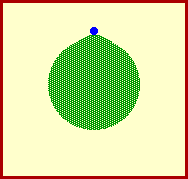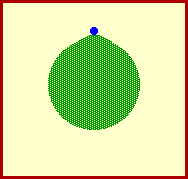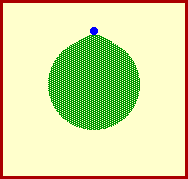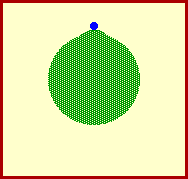Vectors and Projectiles
Satellite
Motion
A satellite is often thought of as being a projectile which is
orbiting the Earth. But how can a projectile orbit the Earth? Doesn't
a projectile accelerate towards the Earth under the influence of
gravity? And as such, wouldn't any projectile ultimately fall towards
the Earth and ultimately collide with the Earth, thus ceasing its
orbit?
These are all good questions and represent stumbling blocks for
many students of physics. We will discuss each question here. First,
an orbiting satellite is a projectile in the sense that the only
force acting upon an orbiting satellite is the force of gravity. Most
Earth satellites are orbiting at a distance high above the Earth such
that their motion is not influenced by forces of air resistance.
Indeed, a satellite is a projectile.
 Second,
a satellite is acted upon by the force of gravity and this force
does accelerate it towards the Earth. In the absence of
gravity a satellite would move in a straight line path tangent to the
Earth. In the absence of any forces whatsoever, an object in motion
(such as a satellite) would continue in motion with the same speed
and in the same direction (the law
of inertia). The force of gravity acts upon a high speed
satellite to deviate its trajectory from a straight-line inertial
path. Indeed, a satellite is accelerating towards the Earth due to
the force of gravity. Second,
a satellite is acted upon by the force of gravity and this force
does accelerate it towards the Earth. In the absence of
gravity a satellite would move in a straight line path tangent to the
Earth. In the absence of any forces whatsoever, an object in motion
(such as a satellite) would continue in motion with the same speed
and in the same direction (the law
of inertia). The force of gravity acts upon a high speed
satellite to deviate its trajectory from a straight-line inertial
path. Indeed, a satellite is accelerating towards the Earth due to
the force of gravity.
Finally, while a satellite does fall towards the Earth, it never
falls into the Earth. To understand this concept, we have to
remind ourselves of the fact that the Earth is round; that is, the
Earth curves. In fact, scientists know that on average, the Earth
curves approximately 5 meters downward for every 8000 meters along
its horizon.  So
if you were to look out horizontally along the horizon of the Earth
for 8000 meters, you would observe that the Earth curves downwards
below this straight-line path a distance of 5 meters. In order for a
satellite to successfully orbit the Earth, it must travel a
horizontal distance of 8000 meters before falling a vertical distance
of 5 meters. Since a horizontally-launched projectile falls a
vertical distance of 5 meters in its first second of motion, a
orbiting projectile must be launched with a horizontal speed of 8000
m/s. When launched at this speed, the projectile will fall towards
the Earth with a trajectory which matches the curvature of the Earth.
As such, the projectile will fall around the Earth, always
accelerating towards it under the influence of gravity, yet never
colliding into it since the Earth is constantly curving at the same
rate. Such a projectile is an orbiting satellite. So
if you were to look out horizontally along the horizon of the Earth
for 8000 meters, you would observe that the Earth curves downwards
below this straight-line path a distance of 5 meters. In order for a
satellite to successfully orbit the Earth, it must travel a
horizontal distance of 8000 meters before falling a vertical distance
of 5 meters. Since a horizontally-launched projectile falls a
vertical distance of 5 meters in its first second of motion, a
orbiting projectile must be launched with a horizontal speed of 8000
m/s. When launched at this speed, the projectile will fall towards
the Earth with a trajectory which matches the curvature of the Earth.
As such, the projectile will fall around the Earth, always
accelerating towards it under the influence of gravity, yet never
colliding into it since the Earth is constantly curving at the same
rate. Such a projectile is an orbiting satellite.
To further understand the concept of a projectile orbiting around
the Earth, consider the following thought experiment. Suppose that a
very powerful cannon was mounted on top of a very tall mountain.
Suppose that the mountain was so tall that any object set in motion
from the mountaintop would be uninfluenced by air drag. Suppose that
several cannonballs were fired from the cannon at various speeds -
say speeds of 8000 m/s, less than 8000 m/s, and more than 8000 m/s. A
cannonball launched with speeds less than 8000 m/s would eventually
fall to the Earth. A cannonball launched with a speed of 8000 m/s
would orbit the Earth in a circular path. Finally, a cannonball
launched with a speed greater than 8000 m/s would orbit the Earth in
an elliptical path. The animations below depict these ideas.
|
Launch Speed less than 8000 m/s
Projectile falls to Earth

|
Launch Speed less than 8000 m/s
Projectile falls to Earth

|
|
Launch Speed equal to 8000 m/s
Projectile orbits Earth - Circular Path

|
Launch Speed greater than 8000 m/s
Projectile orbits Earth - Elliptical Path

|
Two final notes should be made about satellite motion. First, the
8000 m/s figure used in the above discussion applies to satellites
launched from heights just above Earth's surface. Since gravitational
influences decrease with the height above the Earth, the orbital
speed required for a circular orbit is less than 8000 m/s at
significantly greater heights above Earth's surface.
Second, there is an upper limit on the orbital speed of a
satellite. If launched with too great of a speed, a projectile will
escape Earth's gravitational influences and continue in motion
without actually orbiting the Earth. Such a projectile will continue
in motion until influenced by the gravitational influences of other
celestial bodies.
For more information on physical descriptions of motion, visit
The Physics Classroom Tutorial.
Specific information is available on the following topics:
|